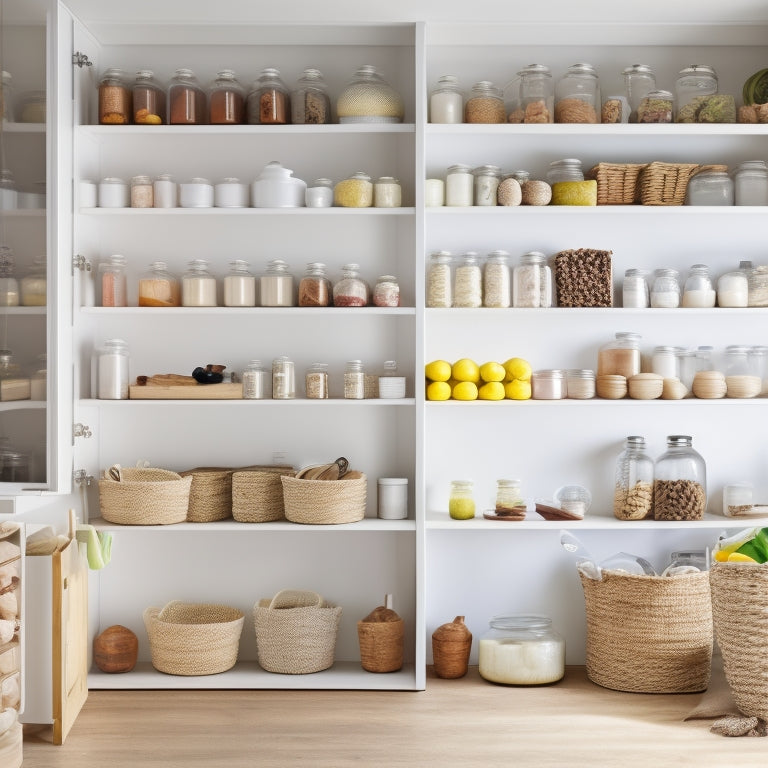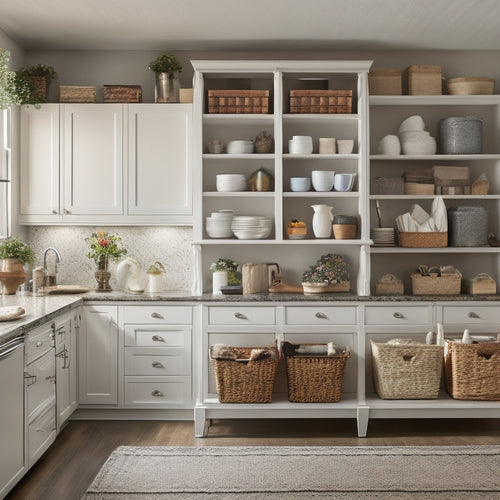
Revamp Your Kitchen: Organize Pantry With Labels
Share
As I revamp my kitchen, I've come to realize that an organized pantry with labels is essential for a more efficient cooking space. By decluttering and categorizing my pantry items, I've saved time and reduced food waste. I've also invested in clear storage containers and baskets to maximize space. To keep track of expiration dates, I use a label maker with bold font and brief descriptions. Now, meal prep is a breeze, and I feel in control of my food inventory. With these simple steps, I've transformed my kitchen - and I'm excited to share more of my pantry organization hacks to get you started.
Key Takeaways
• Organize your pantry by decluttering, repurposing items, and investing in clear storage containers and baskets to maximize space.
• Use a label maker to create bold, descriptive labels with expiration dates for easy identification and tracking.
• Group similar items together and store frequently used items front and center for quick access and efficient meal prep.
• Implement a functional pantry system that reduces food waste and saves time by keeping track of expiration dates and inventory.
• Embrace labeling and organization to gain control over your food inventory, reduce kitchen clutter, and revamp your kitchen workflow.
Pantry Organization Benefits
By organizing my cabinet pantry, I can maximize storage space in my small kitchen, making meal prep a breeze while reducing food waste and saving time.
With a well-organized pantry, I can easily access the ingredients I need, and cooking becomes a joy. Pantry labeling is a game-changer - it helps me keep track of expiration dates, and I no longer have to dig through a cluttered pantry to find what I need.
I've invested in clever storage solutions like clear containers and baskets to keep items visible and within reach. By doing so, I've reduced food waste and saved time, making meal prep a whole lot easier.
Now, I can focus on cooking up a storm and enjoying the fruits of my labor!
Essential Organizing Steps
I tackle the task of decluttering my pantry by sorting items into three piles: keep, donate/sell, and discard, an essential step in creating a more organized and functional space.
Next, I give the pantry a fresh coat of paint to brighten up the interior and create a clean slate for my new storage solutions. I repurpose items like mason jars to store dry goods and invest in clear storage containers and baskets to maximize space.
This step is vital in creating a functional pantry that makes meal prep a breeze. By decluttering and repurposing, I'm able to create a space that's both beautiful and efficient.
Now, I'm ready to take my pantry organization to the next level with efficient labeling strategies!
Efficient Labeling Strategies
How can I guarantee that my pantry labels are both functional and easy to read? The answer lies in creative labeling strategies! I've found that using a consistent font and color scheme helps create a cohesive look. Additionally, I like to group similar items together, making it easy to find what I need at a glance.
| Labeling Tip | Why It Works |
|---|---|
| Use a bold font | Easy to read from a distance |
| Add a brief description | Quick identification of contents |
| Include an expiration date | Ensure freshness and safety |
| Use a label maker | Professional-looking results with minimal effort |
Recommended Storage Essentials
In order to maximize the functionality of your newly organized pantry, it's essential to invest in a few key storage essentials that will help keep your food and kitchen supplies neatly organized and easily accessible.
I've found that storage container options like clear plastic bins, glass canisters, and black storage baskets are perfect for storing dry goods, snacks, and cooking essentials.
Additionally, I recommend incorporating pantry labeling techniques, such as printable label designs, to identify what's inside each container. These storage essentials will help you implement practical pantry organization tips, like categorizing similar items together and keeping frequently used items front and center.
User Insights and Reflections
After implementing these pantry organization strategies, many users have reported a significant reduction in kitchen clutter and a newfound sense of control over their food inventory.
I've heard from users who've decluttered their kitchens, downsized their supplies, and discovered the simplicity of essential items. They've shared their appreciation for labels, which have become a game-changer in their kitchen routines. One user joked that labeling their pantry items has given them a sense of accomplishment, like checking off a to-do list.
As users reflect on their experiences, they've realized that organizing their pantry hasn't only saved them time but also reduced food waste. Their personal reflections highlight the importance of embracing organization and labeling in the kitchen.
Frequently Asked Questions
How Often Should I Clean and Maintain My Organized Pantry?
I'm a big believer in setting pantry schedules to maintain my organized space. I like to dedicate 15 minutes each week to tidying up and restocking. It's a fresh start every Monday morning!
I also do a deeper clean every 3 months, wiping down shelves and reorganizing as needed. This routine keeps my pantry looking and feeling its best, and I can always find what I need in a snap.
Can I Use Chalkboard Labels for a More Rustic Kitchen Look?
Coincidentally, I was just browsing Pinterest for rustic kitchen ideas when I stumbled upon chalkboard labels. I must say, they add a certain charm to the pantry!
For a rustic aesthetic, chalkboard labels are a great choice. They bring a touch of vintage flair and can be easily customized with a chalk marker. Plus, they're easy to erase and reuse, making them a practical choice for my ever-changing pantry inventory.
I'm sold on the chalkboard charm – it's a great way to add some personality to my kitchen!
Are There Any Specific Pantry Organization Methods for Corner Cabinets?
When it comes to corner cabinets, I've found that traditional shelving can be a real pain. That's why I swear by corner carousels and adjustable shelves!
These game-changers help me make the most of that tricky space. I can easily spin the carousel to grab what I need, and the adjustable shelves let me customize the storage to fit my weirdly-shaped containers.
It's a total corner cabinet makeover!
How Do I Deal With Expired or Unused Pantry Items During Decluttering?
When decluttering my pantry, I tackle expired or unused items head-on. I call it the 'Pantry Purge.'
I sort items into three piles: keep, donate/sell, and toss. Be honest, if it's expired or hasn't been used in a year, it's probably safe to let it go.
I hate contributing to food waste, so I try to use up items nearing expiration or give them to friends and family.
It's liberating to rid my pantry of unnecessary items and reduce waste – it's a win-win!
Can I Repurpose Old Furniture to Create a Custom Pantry Storage Solution?
I'm a firm believer in giving old furniture a new lease on life, and my pantry's no exception. I scoured local thrift stores for upcycled shelves and vintage drawers to create a one-of-a-kind storage solution.
With some TLC and creativity, I transformed an old dresser into a functional pantry. Now, my kitchen's got a touch of rustic charm and loads of extra storage for my labeled containers.
Who says you can't teach an old cabinet new tricks?
Related Posts
-

3 Essential Tips to Boost Home Storage Capacity
You're one step away from freeing yourself from clutter chaos! To boost your home storage capacity, start by purging ...
-

10 Best Space-Saving Hacks for Tiny Guest Rooms
You're about to transform your tiny guest room into a cozy retreat that's both functional and aesthetically pleasing....
-

What Makes the Best DIY Storage Ottoman?
When constructing your ideal DIY storage ottoman, consider essential features like color, size, upholstery, and compl...


